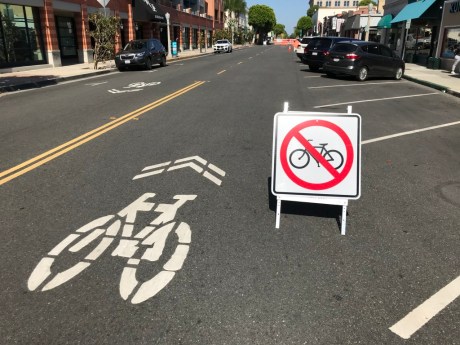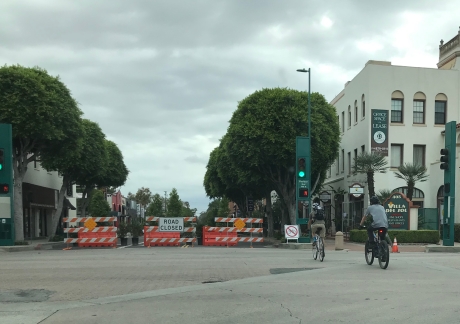
Go ahead, figure it out for yourself.
Matthew Leslie
On Friday, May 22, with virtually no warning, the City of Fullerton closed a short block of West Wilshire Avenue to vehicular traffic, including bicycles, to facilitate a new outdoor dining area in the middle of a public street. Signs and barricades close the street to cars, and, specifically, bicycles, even though the area of the closed street is a segment of the city’s official Wilshire Bicycle Boulevard. According to City Manager Ken Domer, the closure is “tentatively scheduled through November 2nd.”
The closure was attributed by city staff to a desire by the Fullerton City Council for amended outdoor dining plans that would allow restaurants to utilize additional city property for expanded seating areas large enough to accommodate social distancing guidelines. But, according to City Manager Domer, “No specific street or public right of way locations were designated by the City Council.“ Domer himself authorized the closure, “not specifically to close it to bicycles,” but for outdoor dining because of the area’s high concentration of restaurants.
The COVID-19 pandemic has led the state to issue strict guidelines for how restaurants may open, including social distancing requirements that make it difficult to seat enough patrons in side their establishments to make opening worthwhile financially. The city’s solution is to allow restaurants to utilized public spaces like sidewalks and parking lots for outdoor dining.
Orange directional detour signs posted on either side of Harbor Blvd. direct bicyclists north or south on Harbor, not the safest route for many cyclists. Asked if the city recommended that riders use Harbor Blvd. as a detour route, Domer responded “All bicyclists should always use caution on any street they choose to use.”
In response to concerns about the closure, Public Works Director Meg McWade wrote “The intent of the closure is not to hurt the bicycling community. We are trying to work as quickly as possible to help save the downtown businesses due to Covid impacts – and closing Wilshire quickly is an attempt to do so.” After consulting a map, another city staff member suggested that cyclists use Pomona Ave. east of Harbor, but that isn’t where the detour signs are located.

Your tax dollars at work creating confusion.
Domer confirmed that the city’s Active Transportation Committee (formerly the Bicycle Users Subcommittee), which has not met since February, was not consulted about the street closure. At least one of its members, Prof. Vince Buck, has expressed concerns with the closure, writing to Domer that he learned about it only from reading it in the Fullerton Observer.
The Wilshire Bicycle Boulevard begins at the 600 block of West Wilshire, at Woods Ave., east of Euclid Ave., and extends east over two miles to Annin Ave., just west of Acacia, and is a central feature of Fullerton’s Bicycle Master Plan. It connects to other streets officially designated and signed as bike routes, providing safer bicycle passage laterally across most of the city without riders having to use major traffic thoroughfares.
The $ 3.2 million boulevard project was years in planning, and funded primarily with a federal grant through the Orange County Transportation Agency (OCTA), with just $ 300,000 from the City of Fullerton for street paving along the route. Fullerton’s closure of even a small portion of the street calls into question whether the city could be accused of misusing the funds awarded to it by OCTA. The grant funded planning for the boulevard, as well as replacing intersection stop signs with permanent traffic roundabouts, adding directional bicycle “sharrow” markings to the street pavement, and posting permanent signs advising that bicycles may use full traffic lanes on the two lane street.
Under ordinary circumstances, the entire block of East Wilshire between Harbor Blvd. and Pomona Ave. is closed to traffic nearly all Thursday evenings between the months of April and November for the Downtown Fullerton Market, but even then cyclists can walk their bikes through the market, and there is frequently bicycle parking provided near the Fullerton Museum’s beer garden, along with permanent bike racks in the area.
In response to questions raised about the Bicycle Boulevard closure days after it went into effect, Domer indicated that he would have the “no bikes” signs removed, and that bicyclists would be allowed to walk their bicycles through the closed area. Nearly two weeks later, the “no bikes” signs remain.

Cyclists now just ride on the sidewalk, posing a danger to pedestrians.
Although removing the signs might accommodate causal cyclists, it runs counter to the boulevard’s purpose of providing an uninterrupted route for commuters and other riders. A center lane for bicycling, which would restore continuity to the route, is not provided, according to Domer for the safety of pedestrians and diners. Absurdly, what could easily be a center lane, is now a space filled with potted trees in what appears to be a feeble effort to beautify a dining area located in the middle of a street. Cyclists encountering the barricades can easily be observed simply riding their bikes around the closure signs and on the sidewalk instead of in the street, making redundant the city’s excuse that a bicycle lane would endanger pedestrians.
The city needs to rectify the confusing and dangerous situation it created by opening the street back up to cycling now. While other cities are opening their streets up to cycling and pedestrians, Fullerton has closed one off with ugly orange barricades and metal signs. Restore the Bicycle Boulevard with a central travel lane now, or get rid of the tables and potted trees and make turn it back into a public street again.


Barriers have also been put up on Harbor Boulevard to accommodate the daily protests in Anaheim No telling how long that will last but then again is normal what we’re going back to Not according to Gavin Newsom
LikeLike